The geopolitical linchpin that is Saudi Arabia looms large not just in its own neighborhood, but also across the world writ large. Located in the heart of the Middle East (or Southwest Asia/North Africa, SWANA), it’s the birthplace of Islam and the world’s leading exporter of petroleum. With a sprawling landmass that covers the majority of the Arabian Peninsula, Saudi Arabia shares its borders with eight countries, each relationship uniquely shaped by history, politics, and social constructs.
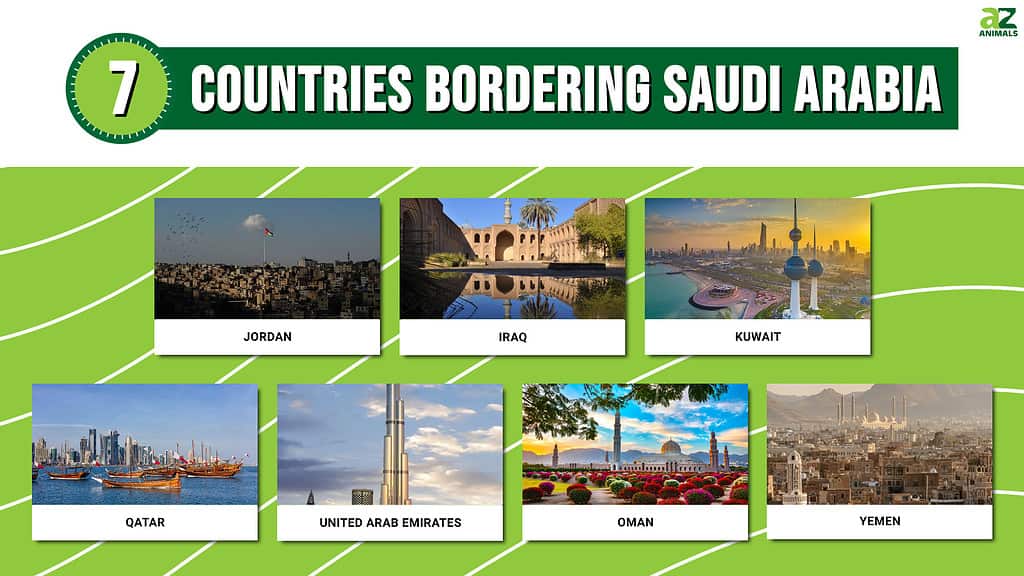
Here, we invite you to a geopolitical tour of Saudi Arabia’s neighbors: Jordan, Iraq, Kuwait, Qatar, the United Arab Emirates, Oman, and Yemen. Through this lens, we explore how these countries interact with Saudi Arabia, highlight their political, economic, and cultural ties, and discuss how these relationships impact the broader region and beyond.
Jordan: Saudi Arabia’s Neighbor to the North
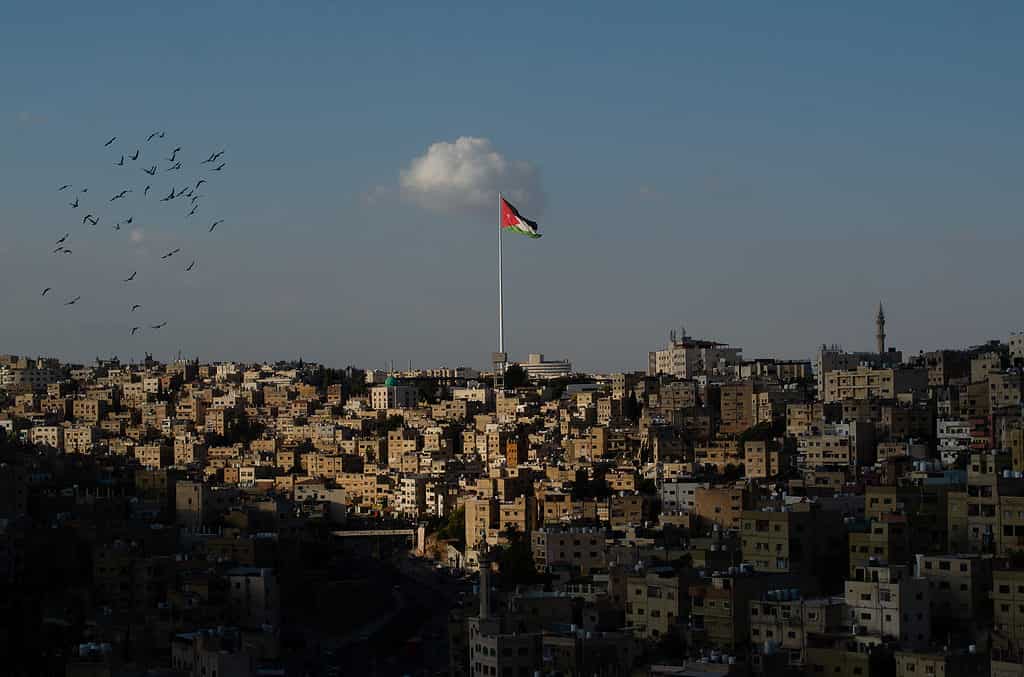
Amman, Jordan’s capital, is also the country’s largest city.
©iStock.com/Abdallah Abo-Elfadle
Geography and Length of the Border
Jordan shares its southern border with Saudi Arabia, a stretch of land that spans approximately 744 kilometers (about 462 miles). This border is predominantly desert terrain, part of the broader Arabian Desert that covers much of the region. Despite the arid conditions, the border is strategically important for both countries, serving as a crucial point for trade and military access.
Political and Economic Relations
Not unlike the United States and Canada, Saudi Arabia and Jordan have generally enjoyed warm relations. These ties have deep roots in shared cultural and religious practices. Both countries are monarchies, albeit of different stripes. The Saudi Kingdom is an absolute monarchy, whereas Jordan is a constitutional monarchy. Additionally, both nations are Sunni-majority countries and have collaborated on various regional initiatives. Their political relationship is characterized by mutual respect and a shared vision for regional stability.
Economically, Saudi Arabia is one of Jordan’s most important trade partners. Saudi investments in Jordan span multiple sectors, including real estate, tourism, and agriculture. Additionally, many Jordanians work in Saudi Arabia, sending remittances that bolster Jordan’s economy.
Cultural Ties
The cultural bond between Saudi Arabia and Jordan is rooted in their shared Islamic heritage. The annual Hajj pilgrimage to Mecca, one of Islam’s Five Pillars, is a significant event that strengthens these cultural and religious ties. Jordanians also contribute to Saudi Arabia’s academic and professional sectors, providing expertise in fields such as medicine, engineering, and academia.
Challenges and Opportunities
Despite the generally amicable relations, there are challenges. Saudi Arabia’s shifting alliances and the evolving geopolitical landscape in the Middle East have occasionally caused tensions. However, both nations continue to work towards strengthening their bilateral relations through diplomatic visits, trade agreements, and regional cooperation.
Iraq: Former Enemy and Potential Partner in the Making

This ancient school in Baghdad, Iraq’s capital, reminds us of this most ancient of cities and how it was once one of the most prestigious educational centers of the world.
©Asnm663/Shutterstock.com
Geography and Length of the Border
Iraq lies to the northeast of Saudi Arabia, with its border stretching around 814 kilometers (roughly 506 miles). Unlike the southern border with Jordan, the Saudi-Iraqi boundary is more complex due to natural barriers such as the Wadi Al-Batin River and the Nafud desert.
Political and Economic Relations
Historically, Saudi-Iraqi relations have been fraught with tensions. The Iran-Iraq War in the 1980s and the Gulf War in the early 1990s put Saudi Arabia and Iraq on opposite sides of regional conflicts. However, in recent years, the relationship has shown signs of improvement. Saudi Arabia has engaged in diplomatic efforts aimed at stabilizing Iraq, partly to counter Iranian influence in the country.
Economically, trade between the two nations is growing but remains far below its potential. Saudi Arabia has shown interest in investing in Iraq’s reconstruction and energy sectors. War-scarred Iraq remains cautiously open to discussions.
Historical Context
The complex relationship between Saudi Arabia and Iraq can be traced back to their contrasting political ideologies and alliances. While Saudi Arabia has been a longstanding ally of the United States, Iraq, under Saddam Hussein, was a Soviet ally and later became a regional adversary. The fall of Saddam in 2003 allowed for a “reset” in Saudi-Iraqi relations. This thawing of relations is ongoing.
Challenges and Opportunities
The overarching challenge in Saudi-Iraqi relations is the Iranian factor. Iran’s influence in Iraq is a concern for Saudi Arabia, which views Tehran as a regional rival. Yet, this challenge also presents an opportunity for both nations to engage in dialogue and build a relationship based on mutual interests, such as combating terrorism and fostering economic growth. Despite these shared interests, tensions continue to build between the two countries.
Kuwait: Partners in Petroleum
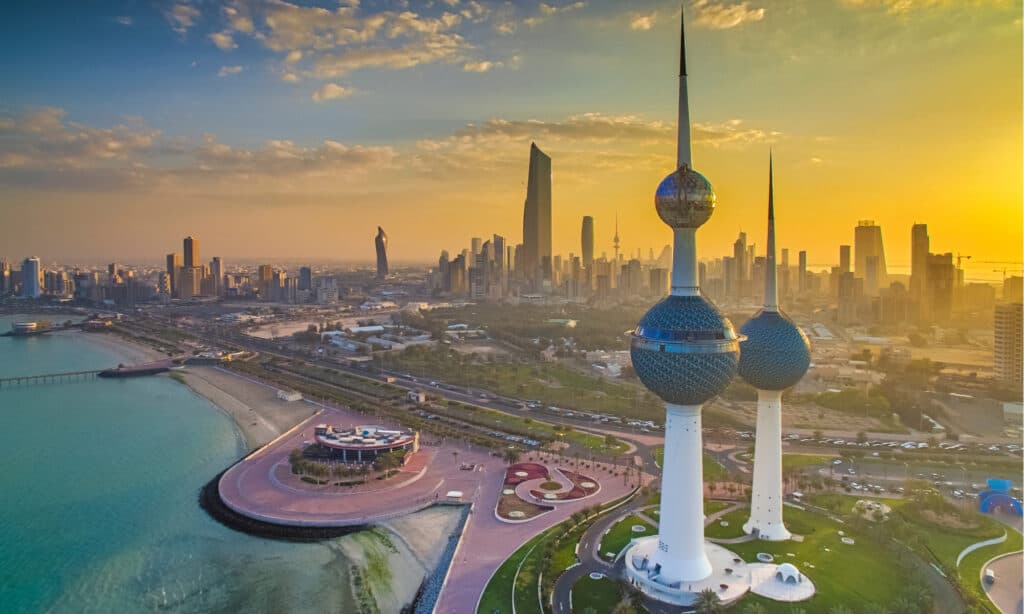
Though its capital, Kuwait City, straddles a bay, the country does not have any rivers.
©Anson Fernandez Dionisio/Shutterstock.com
Geography and Length of the Border
Kuwait, one of Saudi Arabia’s smallest but most strategic neighbors, is located to the northeast. The two countries share a border that is approximately 221 kilometers (about 137 miles) long. This relatively short span is significantly influenced by the presence of oil fields. In particular, it includes the Partitioned Neutral Zone, an area rich in petroleum resources that is jointly managed by both nations.
Political and Economic Relations
Saudi Arabia and Kuwait share a history of political and economic collaboration. Both are founding members of the Gulf Cooperation Council (GCC), a regional alliance that aims to foster economic, scientific, and business cooperation. Their relationship is further solidified by a range of bilateral agreements covering everything from trade and investment to security and defense.
The energy sector is a cornerstone of their economic relations. Both countries equally share the oil production from the Partitioned Neutral Zone and make joint decisions on production.
Gulf Cooperation Council (GCC) Implications
As GCC members, Kuwait and Saudi Arabia often align on regional issues, whether it’s regarding Iran’s nuclear program or the crisis in Yemen. Their collaborative stance extends to various sectors including education, healthcare, and technology.
Challenges and Opportunities
While the relationship is generally positive, it is not without its challenges. Disagreements over border demarcation and oil production quotas have occasionally strained relations. However, diplomatic channels have usually been effective in resolving such issues.
Looking ahead, several opportunities for further collaboration are on the horizon. As both countries seek to diversify their economies away from oil, sectors like tourism, renewable energy, and technology offer new paths for mutual growth and investment.
Qatar: The Once Black Sheep
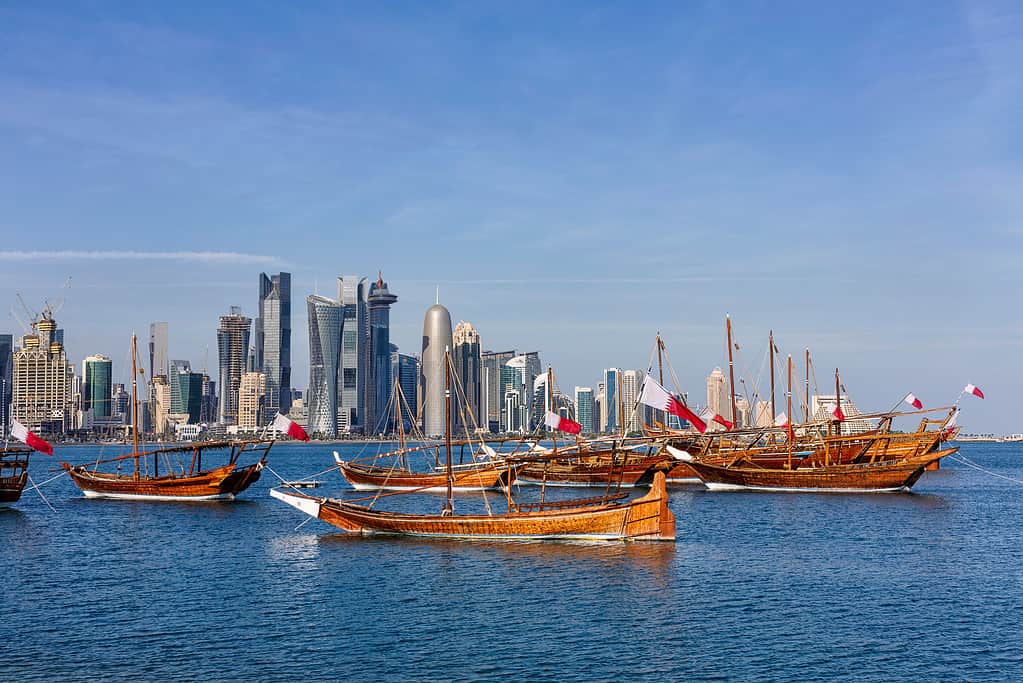
Once its regional neighbors imposed a blockade on Qatar, it reached out to the broader world.
©Davor Flam/Shutterstock.com
Geography and Length of the Border
Qatar shares a relatively short land border with Saudi Arabia, stretching just about 87 kilometers (approximately 54 miles). Located on the eastern side of the Qatari peninsula, this border is the country’s only land route, making it vital for trade and transport.
Political and Economic Relations
The relationship between Qatar and Saudi Arabia has been turbulent in recent years. In 2017, Saudi Arabia, along with the United Arab Emirates, Bahrain, and Egypt, imposed a blockade on Qatar, accusing it of supporting terrorism and maintaining close ties with Iran. This led to a severing of diplomatic and trade relations.
However, the situation improved significantly in 2021 when the blockade was lifted. Diplomatic ties were restored, and the two countries began rebuilding their relationship. Trade has since resumed, and Qatari flights are again permitted to use Saudi airspace.
Blockade and Its Impact
The blockade had a profound impact on both nations, but especially so in Qatar. The smaller nation had to reroute its imports and develop new trade partners. Interestingly, the blockade also led Qatar to focus on self-sufficiency, particularly in the food sector, and has strengthened its ties with countries outside the Gulf.
Challenges and Opportunities
The lifting of the blockade has opened a new chapter, which can be argued is really an older chapter, in Saudi-Qatari relations. While challenges remain, particularly concerning Qatar’s relationship with Iran and its Al Jazeera network’s often critical coverage of Saudi policies, there are also many opportunities to promote their shared interests. As both nations are looking to diversify their economies, possibilities for collaboration in sectors like technology, healthcare, and renewable energy, present themselves.
United Arab Emirates (UAE): Shared Wavelengths
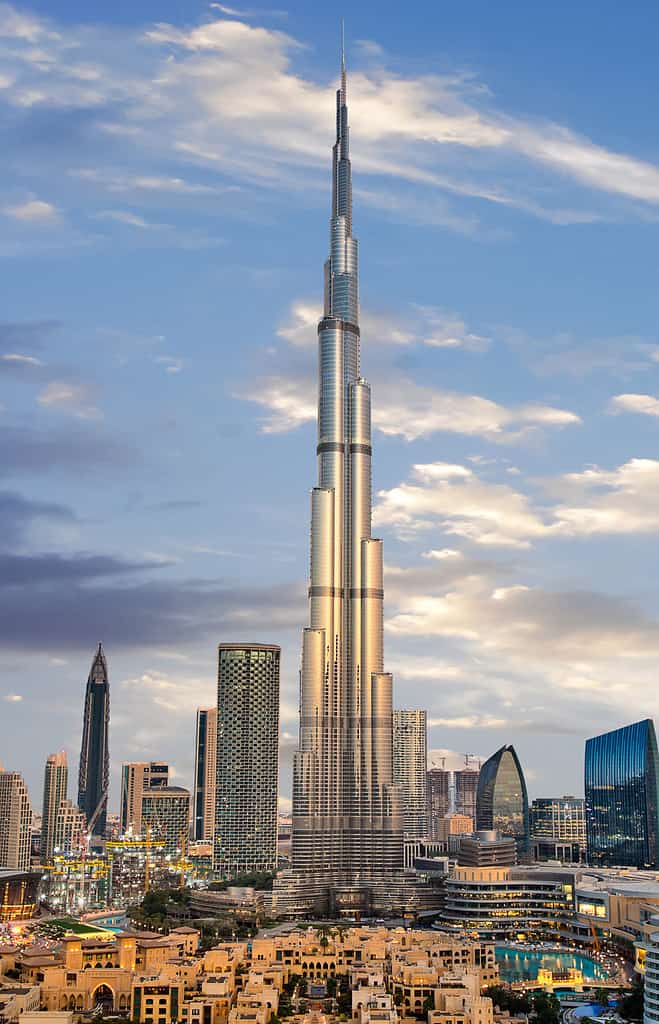
The UAE is home to the tallest building in the world, Dubai’s Burj Khalifa.
©Lukas Gojda/Shutterstock.com
Geography and Length of the Border
The United Arab Emirates, commonly known as the UAE, shares its southern border with Saudi Arabia. This border extends for about 457 kilometers (approximately 284 miles) and is marked by desert terrain, like Saudi Arabia’s other borders.
Political and Economic Relations
Saudi Arabia and the UAE share a deep and multi-faceted relationship. Together, they’re often considered the backbone of the GCC. To be sure, they are close allies who usually adopt similar stances on regional and international issues.
Economically, the UAE is one of Saudi Arabia’s most important trading partners. Their trade relationship spans various sectors, including oil and gas, construction, and finance. The UAE also hosts a significant number of Saudi businesses and professionals.
Shared Objectives and Challenges
Both nations have embarked on ambitious economic diversification plans. Saudi Arabia’s Vision 2030 and the UAE’s Vision 2030. These visions share objectives such as reducing dependency on oil, promoting tourism, and investing in technology and renewable energy.
However, despite the general alignment, disagreements do arise. For example, the two countries have had differing opinions on the Yemen conflict and the OPEC+ oil production limits. Yet, their strong diplomatic ties usually allow for the resolution of such issues through dialogue.
Oman: The Regional “Switzerland”
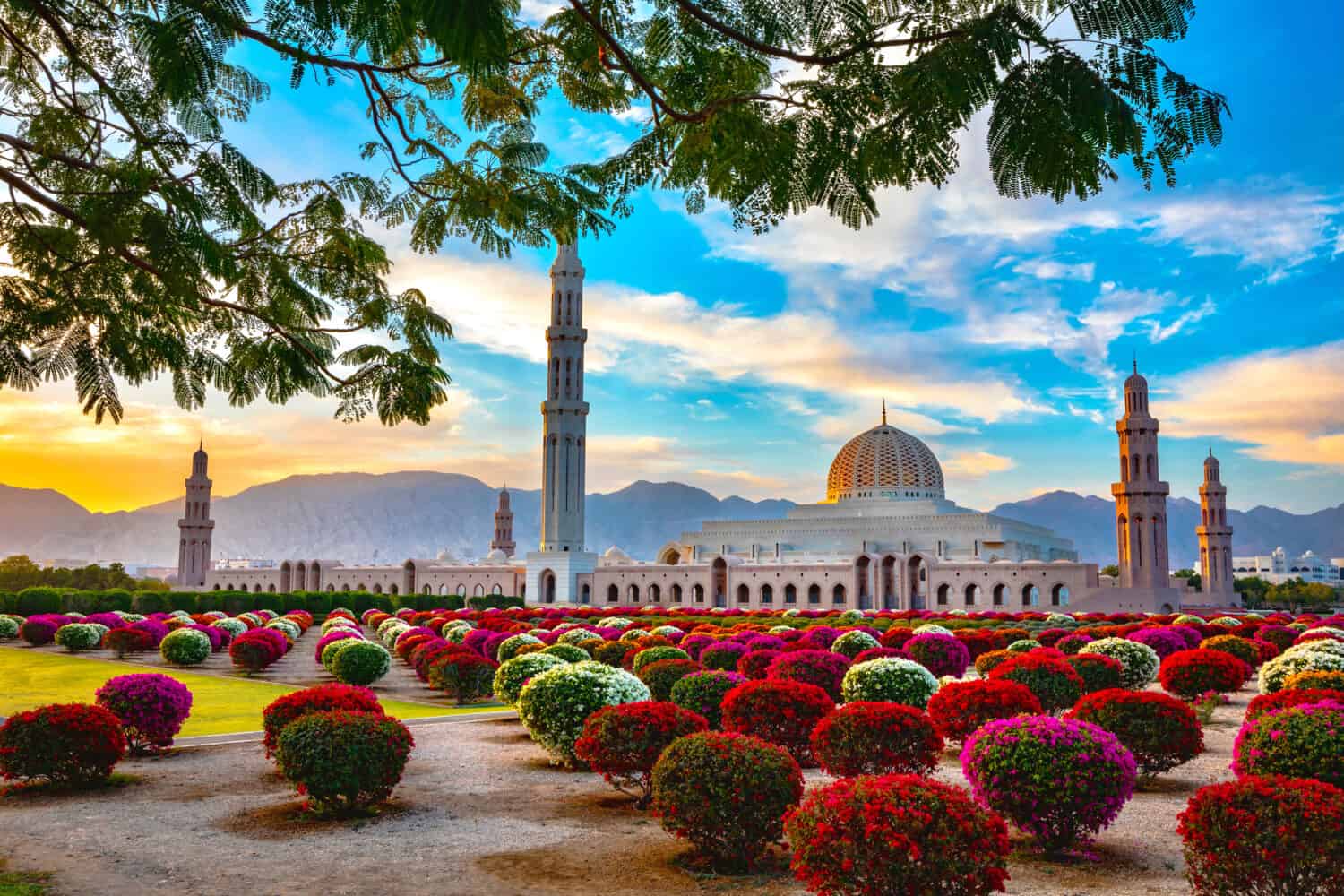
Muscat, the capital of Oman, is a picturesque city set between the Bay of Oman and the Al Hajar Mountains. Pictured here is the city’s Grand Mosque.
©Djay7/Shutterstock.com
Geography and Length of the Border
Oman, located to the southeast of Saudi Arabia, shares a border that stretches around 676 kilometers (about 420 miles). This border consists mainly of desert and mountainous terrain. Further, though the stretch is less populated, it’s strategically important. This fact gives Oman a unique geopolitical stance in the region.
Political and Economic Relations
Oman and Saudi Arabia maintain a cordial, though not as deeply intertwined, relationship compared to Saudi Arabia’s other Gulf neighbors. Unlike most GCC members, Oman has maintained a more neutral foreign policy, often acting as a mediator in regional conflicts.
Economically, the relationship is moderate but growing. Saudi Arabia exports a variety of goods to Oman, including electrical equipment and building materials. In turn, Oman exports products like aluminum and various (non-petroleum) chemicals to Saudi Arabia. Recent years have seen an uptick in Saudi investments in Oman, particularly in the 2,000-square-kilometer (around 772 square miles) Duqm Special Economic Zone.
Unique Aspects of the Relationship
Oman’s neutral stance in regional politics makes it a unique partner for Saudi Arabia. For example, Oman has maintained good relations with Iran, Saudi Arabia’s regional rival, and has often acted as a backchannel for diplomatic communications.
Challenges and Opportunities
As noted above, one of the challenges in Saudi-Omani relations is Oman’s relationship with Iran. However, this also offers a unique opportunity: Oman can act as a bridge between Saudi Arabia and Iran, potentially easing regional tensions.
Additionally, Oman’s diversification efforts under its Vision 2040 offer new opportunities for Saudi investment. Its oil-rich neighbor is likely to find sectors like tourism, logistics, and manufacturing, to be appealing investments.
Yemen: Rugged Conflict Zones
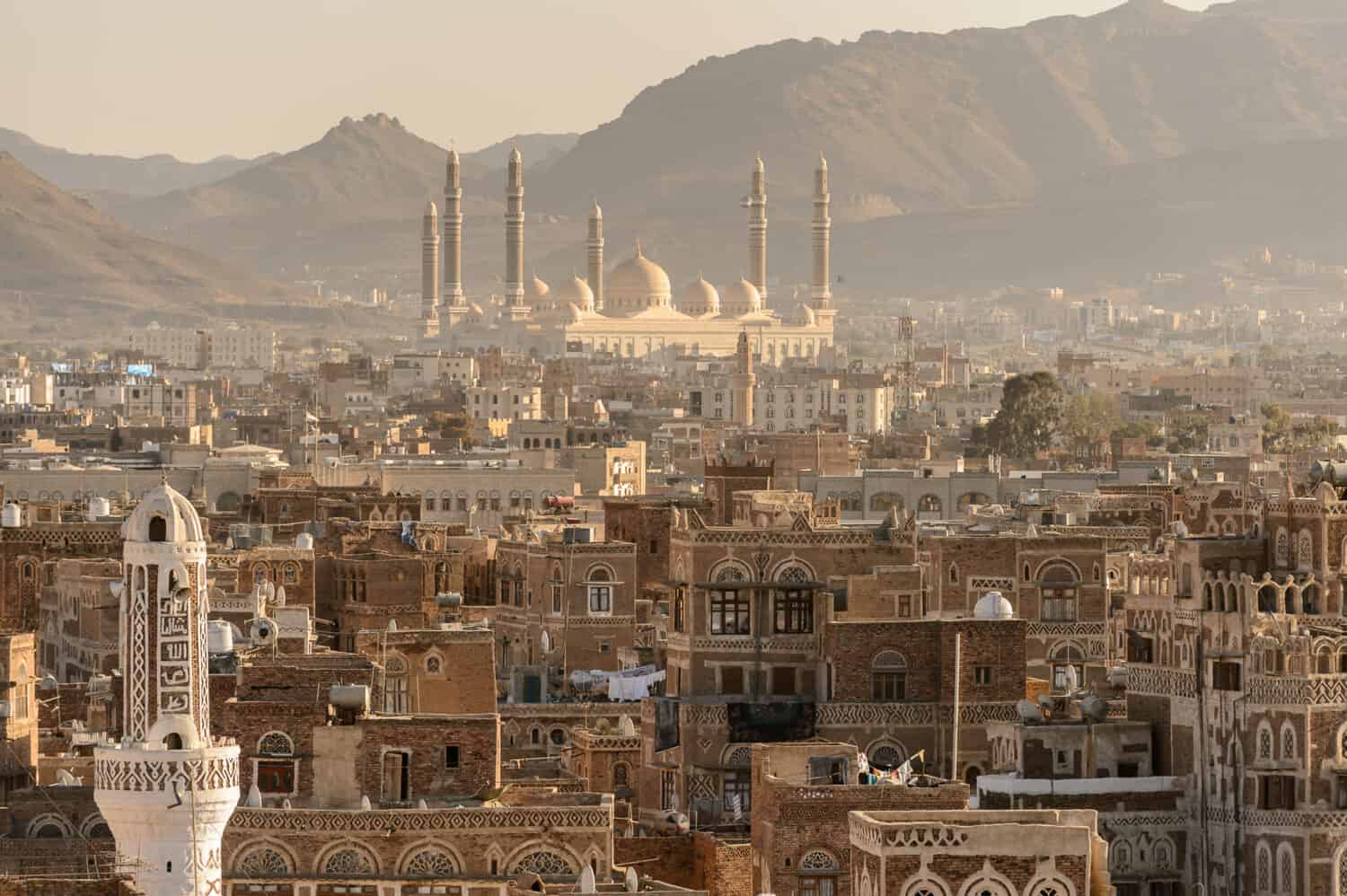
The Old Town of the Yemeni capital city, Sana’a (also spelled Sanaa and Sana), is a UNESCO World Heritage site.
©Anton_Ivanov/Shutterstock.com
Geography and Length of the Border
Saudi Arabia shares its southern border with Yemen, a stretch that runs approximately 1,307 kilometers (about 812 miles). This border is not just long but also complex. It’s composed mainly of rugged mountainous terrain with several crossing points and runs mainly along the vast Rub’ al Khali (“Empty Quarter”) desert, the largest sandy desert, or sand sea, in the world.
Political and Economic Relations
Saudi-Yemeni relations are currently defined by the ongoing conflict in Yemen, in which Saudi Arabia leads a coalition against the Houthi rebels. This has strained relations and led to a humanitarian crisis that affects both countries.
Economically, the relationship is imbalanced. Yemen is dependent on Saudi aid and remittances from Yemeni workers in Saudi Arabia. The conflict has severely impacted this economic dynamic, with Saudi Arabia also suffering from sporadic cross-border attacks.
The Ongoing Conflict and Its Implications
The conflict in Yemen is the most significant point of tension in Saudi-Yemeni relations. Saudi Arabia views the Houthi rebels, who are supported by Iran, as a threat to regional stability. The war has resulted in a significant loss of life and has drawn international criticism.
Controversial Issues: Saudi Arabia in the Global Spotlight
Saudi Arabia and 9/11
Saudi Arabia’s ties to 9/11 are a contentious and sensitive subject that has been the subject of numerous investigations, lawsuits, and debates. Some key points include:
The Involvement of Saudi Nationals
15 of the 19 hijackers involved in the 9/11 attacks were Saudi citizens, as was Osama bin Laden, the leader of Al Qaeda. Some of these individuals had contacts with Saudi officials or agents in the US, raising questions about the extent of Saudi involvement.
The Role of the Saudi Government
While the US government states that it found no evidence of the Saudi government funding or directing the attacks, critics argue that, based on the evidence, lower-level officials or broader governmental scrutiny is warranted.
Release of Classified Documents
Calls for the declassification of documents related to Saudi Arabia’s ties to 9/11 have been partially answered. However, what has been released so far has not provided conclusive evidence of Saudi complicity.
Saudi Arabia and Human Rights
Saudi Arabia faces global criticism for its human rights record. Some of the most notable ones leveraged include:
(Over)Use of the Death Penalty
Saudi Arabia is one of the world’s leading executioners, drawing condemnation for the range of crimes that can result in the death penalty.
Repression of Dissent
The nation has been criticized for its treatment of activists, journalists, and others who voice opposition or call for reforms.
Discrimination Against Women
While some reforms have been enacted to improve women’s rights, critics argue that much more needs to be done.
Mistreatment of Migrants
Millions of migrant workers in Saudi Arabia face poor working conditions and lack legal protection, a situation that has drawn international concern.
The Murder of Jamal Khashoggi
The 2018 murder of Saudi journalist Jamal Khashoggi drew international condemnation and put Saudi Arabia under intense scrutiny. The case remains unresolved, with ongoing debates about who bears ultimate responsibility and what the global community’s response should be.

Though the Kingdom has been hard at work diversifying its economy to reduce oil dependency since the 1970s, Saudi Arabia recently announced plans to invest significantly in what would be the world’s largest petrochemical complexes ever.
©Avigator Fortuner/Shutterstock.com
Saudi Arabia’s Energy and Sustainability Initiatives in a Changing Climate
The Contorted Energy Paradox
Saudi Arabia’s role in global energy production places it at the center of a paradox. As the world’s largest exporter and producer of oil, the Kingdom’s economy is deeply entwined with, and greatly dependent upon, fossil fuels. Yet, like the rest of the planet, it also faces the existential challenges of climate change. Particularly troublesome for the Gulf state are rising temperatures, water scarcity, and desertification. Of course, these issues don’t only impact Saudi Arabia, but also have significant global implications.
The Carbon Footprint: Direct and Indirect Contributions to Climate Change
Direct Emissions
Saudi Arabia emitted approximately 600 million tons of CO2 in 2019, ranking 12th globally and 4th in the Middle East. Its per capita emissions were about 17 tons, more than three times the global average.
Indirect Emissions
In 2020, Saudi Arabia exported about 7.3 million barrels of oil per day. These exports were responsible for roughly 1.1 billion tons of CO2. This is almost double its direct emissions.
Navigating the Path to Sustainability
Recognizing the urgency of the situation, like much of the developed world, Saudi Arabia has announced various plans and initiatives aimed at mitigating its environmental impact and diversifying its energy sources.
The Saudi Green Initiative
Launched in March 2021, this strategy aims to reduce carbon emissions by 60% and shift 50% of the energy mix to renewables by 2030. Additionally, in order to combat desertification, the Kingdom plans to plant 10 billion trees.
The Middle East Green Initiative
This regional project, also proposed in 2021, involves 40 countries in the Middle East and North Africa. It aims to reduce carbon emissions by 60% by 2030 and to plant 50 billion trees in the region, thereby creating the world’s largest green belt.
The Neom Project
This planned mega-city in northwestern Saudi Arabia aims to be a global model for sustainability and innovation. It promises to run on 100% renewable energy and focus on zero-emission transport and smart infrastructure.
Given the Kingdom’s role, past and present, in contributing to the climate crisis, there are many critics of its green plans. Some note that aspects of the plans depend on the Kingdom producing even more oil. Others point to the technological optimism required to consider such projects feasible in the first place. Whether it’s greenwashing on a massive scale, a real response to clear and present dangers, or a mix of both, only time and actions will tell.
Conclusion: The Balancing Act
Saudi Arabia is at a critical juncture, grappling with the dual identity of being both a global fossil fuel energy titan and a nation under the looming threats of climate change. Its intricate relationships with neighboring countries, coupled with its own internal challenges, make it a pivotal player in the geopolitics of the Middle East and beyond.
The sustainability initiatives and climate plans it has set forth present a vision for change. Yet, it’s the tangible impact of these actions that will define Saudi Arabia’s role in a world increasingly conscious of, and sensitive to, environmental sustainability and human rights. As the Kingdom moves forward, the choices it makes will not only shape its own future but also influence the dynamics of the Middle East and have far-reaching global consequences. As environmental imperatives change, even the wealthiest nations may find that the resources that once built their prosperity are, like the vast desert sands, slipping through their grasp.
Summary of 7 Countries Bordering Saudi Arabia
| Country | Location | |
|---|---|---|
| 1. | Jordan | Borders Saudi Arabia to the north |
| 2. | Iraq | Borders Saudi Arabia to the northeast |
| 3. | Kuwait | Borders Saudi Arabia to the northeast |
| 4. | Qatar | Borders Saudi Arabia to the east |
| 5. | United Arab Emirates | Borders Saudi Arabia to the south |
| 6. | Oman | Borders Saudi Arabia to the southeast |
| 7. | Yemen | Borders Saudi Arabia to the south |
The photo featured at the top of this post is © KhaledSaad001/Shutterstock.com
Thank you for reading! Have some feedback for us? Contact the AZ Animals editorial team.







